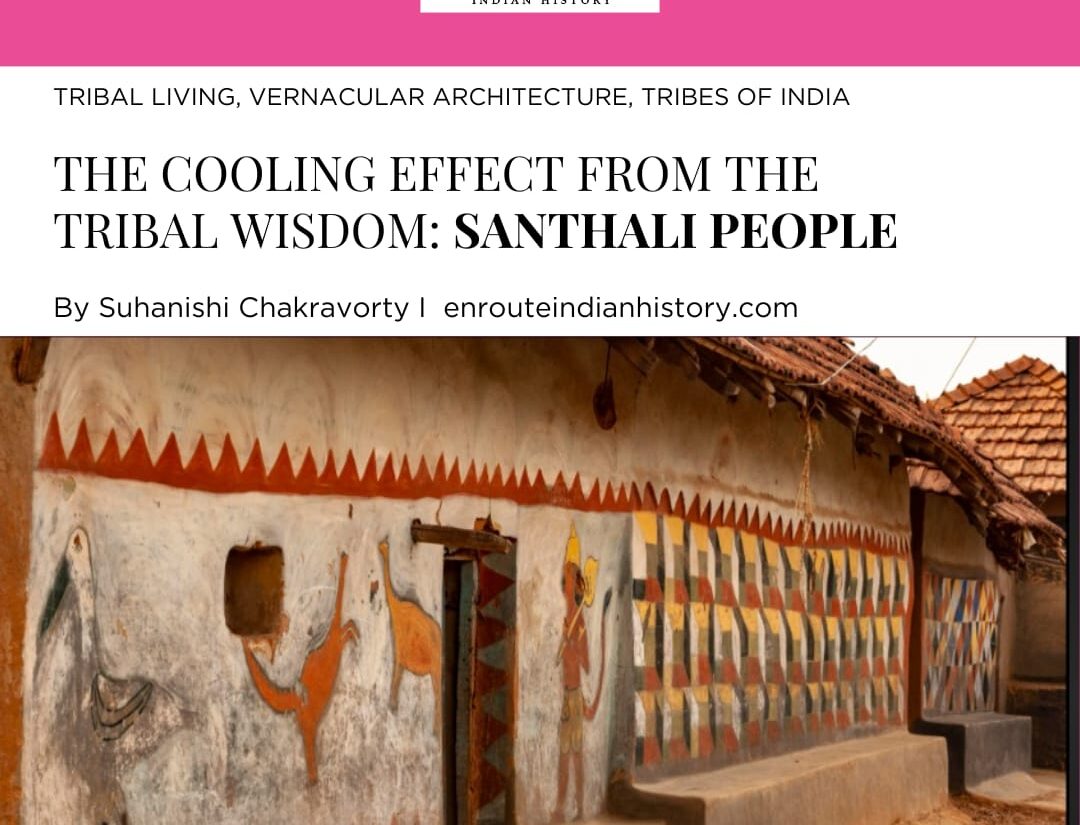
The cooling effect from the tribal wisdom: Santhali people
As we move towards modernity with an aggressive zeal with each passing day there is an undercurrent of realization that makes us wonder are we really well equipped for that? The community lifestyle of the Santhali tribe has a lot to offer. This particular tribe is extensively popular for being initially an artistic nomad community who developed strong architectural and societal norms that happens to be far more independent and respectful towards nature than the mainstream urban literate society (Hembram, 2024). As the heatwave and it’s consequences are becoming unbearable in most part of India we perhaps need to peek at the traditional ways in which the Santhali community has helped to keep themselves cool in all these years. However, the situations are not exactly the same as it was a couple of decades ago. One cannot easily find people from the community even who would smell the water from a spring and accurately predict if there is fish in it or someone who would calculate the direction of the wind and warn their community if a storm is coming or drought. However, since the European individualistic philosophy of society has not been able to pierce through these communities that extensively we still have some nooks and corners in the deep forest areas where community benefit is prioritized over personal wealth generation. The fundamental approach of the Santhali heat management is constructed on their respect for the nature. No wonder it is not just the techniques we need to learn from them.
How is the house afterall?
Santhali community essentially has been a nomad tribe. Which means they have a history of relocation from one space to another. Several factors are involved in this relocation but majorly the resource management could be highlighted. This is a community hugely dependent on the nature that they are surrounded by. It is only recently identified that the community is now at the second stage of ‘rural agrarian’ from being ‘hunters and gatherers’ according to social development theory. However, combining these two stages their tribal wisdom is peccable in addressing some of the crucial ans very basic crisis of the contemporary society (Kisku, 2024).
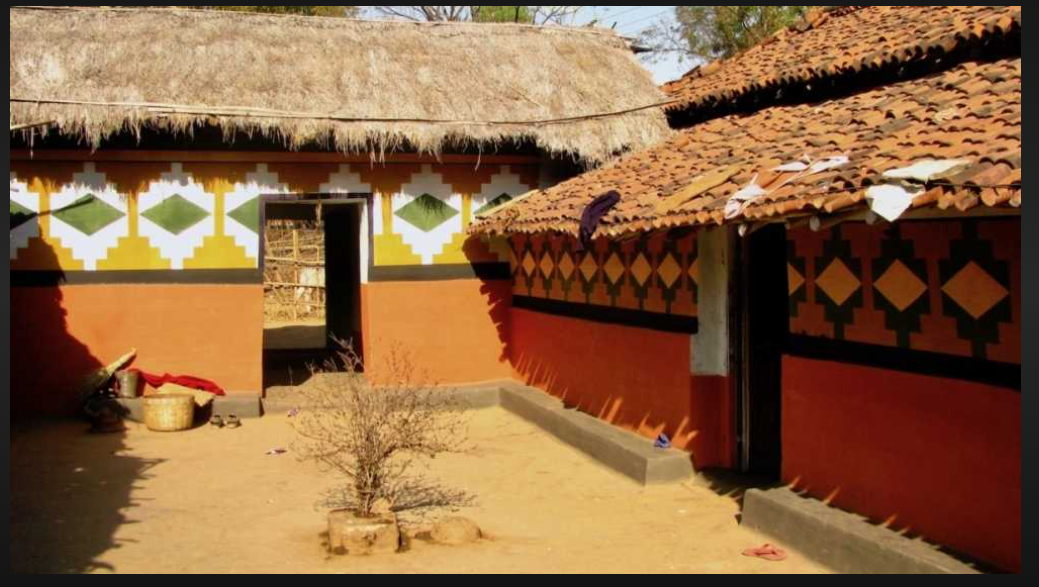
(The beautiful patterns, source: tribehool)
The first thing that a does when moving in a new location is to plant bamboo trees at back of the household. This tree will then be the major resource for raw materials for constructing the house and a constant shade to keep the home cool. A bamboo tree spreads quite easily along the soil line hence it is one of the very wise decisions taken. The whole of the house is developed by the people who will inhibit. In other words, the owner and his family makes the hut himself instead of hiring other people (Kisku, 2024). This allows the community to select number of windows and open spaces within the house by keeping the number of people in mind.
A typical Santhali house has five sections to it. The ‘Bonga Orah’ or the worship room which is used to evoke and worship the spirits of the ancestors. This is a room also very special because it is accessible to only people who are part pf the family. Even a married daughter looses right to enter this room while she gains right in her in laws’ house (Deb, 2022).
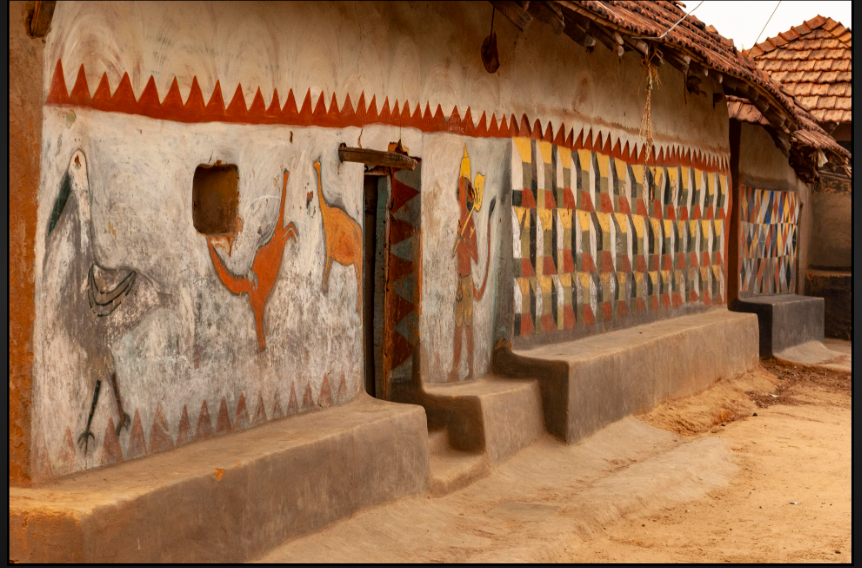
(withered painting, source: reddit)
Then there is Gitich Orah, the bedroom which could be anywhere is the house but is designed in a way that ventilation and privacy are maintained. The Gora Orah, the cowshed that is essentially at side of the house but is easily accessible. The Doka Orah, this is the kitchen and finally the most important one the Racha or the Courtyard. These five elements are an absolute requirement in any Santhali house hold. By looking at the mandatory requirements we can find some basic non-negotiable adjustment in the household that is already making the mud house a much better option to live in any of the flats at the urban area where one needs to pay quite an additional sum to get a balcony that too faces walls.
The making of the house
Unlike the urban creations that are largely dependent on the market bought raw materials and labors a Santhali village would be filled by people who make their own house from locally sources material. Mud is the main factor that erects these houses but there are variety of mud along with their production style.
First, the roof is made. It is the Saal tree or the Bamboo trees or both. The basic structure is by the Saal woods which is about 15 cms thick. Then the supporting beams are constructed with the help of bamboo logs. On this structure the clay tiles or the hay stacks are put. The whole system functions as a clear insulator from the heat.
Then the floor is constructed. If not completely in the first place but the area is cleaned where mud plaster will be applied later on. Then, it is the cowdung primer that needs to be applied each time for a better application on it. The process has to be repeated once every week (Majhi, 2001). If this is followed each time then these floors are as smooth as any modern technology. The only difference with the modern lifestyle is that it calls for maintenance more often and by the people who are inhabiting in the house.
Santhali tribe could be found mostly on the Chhotanagpur plateau which is a land of red soil. The predominance iron on this soil gives it a hardy structure even when in the liquid form. Women of the house hold source this laterite from locality and bring it to the desired consistency by kneading it with water and hand to make the initial structure of the house. Then walls and the structures are constructed and maintained with this. The insulating nature of the mud keeps the house cool in the first place from the core (Kisku, 2024). The major heat resisting capacity comes from the thorough yet multiple layers. In order to keep the layers functional and erect three to four layers of this iron mud is applied. However, the reason for using this material is that it hardens when left to dry. The width of these mud houses are generally about 40 cm which could be called quite a thick one.
Once this hardens up then a layer of mud plaster is applied. This is not the iron mud rather the smooth ‘Belemati’ or the sandy loam. This mud is mixed with the cowdung to make the plastering. Two layers of this mud is applied. This layering offers additional support from the heat and thickens the walls. Finally a greyish mud from the rice fields are collected to make yet another layering. This layer provides a blackish color that looks aesthetically pleasant. This is also layer that is used as canvas for the Santhali women to draw intricate patterns as decorations. Some are traditional patterns, some tell their story and some are recent geometrical experimentations.
Some alternative house structures
The entire heat management is done with help of the knowledge about nature and their potential utilizations. Let us look at some of the other houses where this character is evidently found.
Straw house or ‘Jhanti Orah’
This is a house constructed entirely with the help of bamboo or similar strong branches. There floor is traditionally made with the same sandy loam and cowdung mixed plaster and the roof is thatched with hay. While there are no possibilities of windows in it still it serves as shelter from the sun. This is actually for not inhabiting rather the tradition rice beer is made here and sold in this kind of houses.
Kumbah Orah
This is the same straw house but with a layer of mud on the walls. These kinds of houses are little more secure than the ‘jhanti Orah’ but still is risky to live in by humans if proper care is not taken. Still the mud plays a huge role as an insulator.
Log house or ‘Buruj Khunti Orah’
This is a house that has logs in the dominating characters. The words ‘Buruj’ denotes tower and Khunti alludes to log. The entire house is made with essentially the big heavy trunk of age old trees. Rice husk and mud is used to make the walls of the house. The unique characteristic of these houses make it extensively helpful to keep the heat away (Alam, 2018).
Drinks in the summer
It is very important to note that when we are trying to trace drinks that are works as cooler the preservation style becomes important almost as same as the materials. The water for example is kept inside mud jars and pitchers that are specially created for holding a huge amount of water and insulate it. The pottery is also made with sandy mud that are natural insulators. The water is kept at an elevated pedestal inside the already cool mud houses. The reason for the elevation is to keep it away from pets and kids. Besides water there are abundant rice beer that are quite an attraction for the men to gather after a warm day and chill in the evening. The drink has also shown body cooling properties.
A very big failure is still there
While these intricate artistic and carefree nomad tribe has been practicing the best heat management that could be along with the wisdom it has definitely not reached the masses. Studying the social and historical events that has lead to this might help to identify why that might happen but it does not help those who are in need. The foundation of the Santhali life and philosophy are love towards nature and prioritizing community development rather than individual ones. It is not common to find one single rich family in a Santhali village rather if the community disciplines are properly followed then the whole village would have benefits. The ancient tribal wisdom teaches everybody to come under the same roof and discuss community problems together. Nobody is special and nobody is separate.
The community however now is slowly moving towards the direction of actually leaving these ancient practices behind. One major and perhaps the only reason behind this is the earning of living. Noone had ever supported these community by means of materialistic exchanges. As a result, they had to rely on skills and sectors for which they are at a disadvantage. The Santhali wisdom is
The community however now is slowly moving towards the direction of actually leaving these ancient practices behind. One major and perhaps the only reason behind this is the earning of living. Noone had ever supported these community by means of materialistic exchanges. As a result, they had to rely on skills and sectors for which they are at a disadvantage. The Santhali wisdom of sharing is not workable skill to earn bread and butter. Hence, the newer generation is moving towards using their skills of mud house making for resorts and hotels. These are essentially urban structures that does not celebrate the wisdom but just the lifeless fashion of it. The essence of this living has reached the urban as a brand and not as a way of life. As a result, we now see poor imitations of urban household structures in even some of the rural areas of the West Bengal, Orissa or anywhere that is in contact with the urban lifestyle. The community is becoming cornered each day and the so are their technologies.
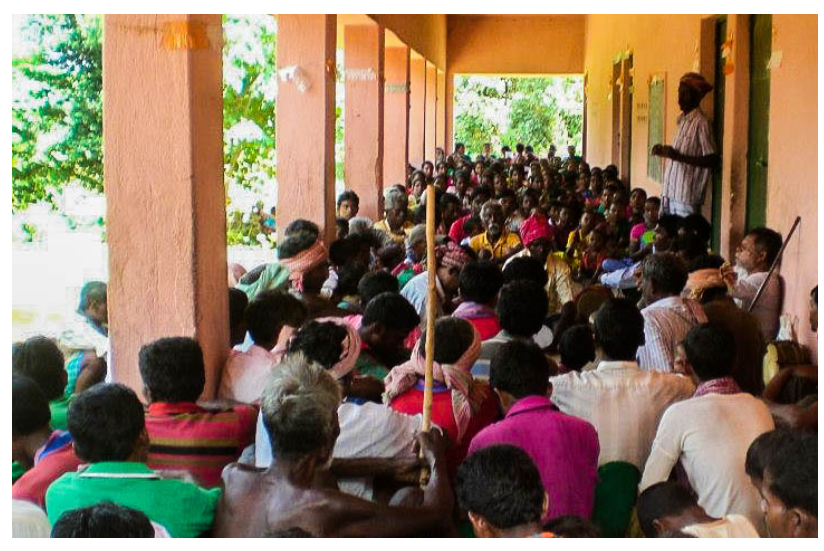
(Santhal meeting, source: santal.com)
With global warming almost starting to claim on lives it is high time that the humanity learns to cope up with the difficulties with the help of brain rather than money. India has been fortunate enough to receive cultural and social wisdom from various communities. Some have brought these excellences from foreign grounds while some have been developed in this soil for with long years of trial and error. While learning and imitating others gives an comprehensive idea about the various kinds of wisdom but replying on what is available is more prudent at the moment. To know our future we need to our present better and the Santhali tribal wisdom is definitely way ahead of us, even in very immediate issue like heat management.
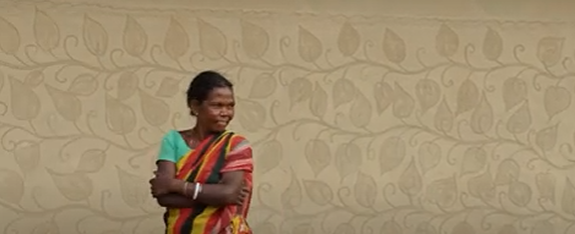
(A Santhali women in front of her art, source: Daricha foundation)
Bibliography
Alam, S. (2018) Santhal tribes in Jharkhand are reviving an old, low-cost tradition to get safe drinking water, Scroll.in. Scroll.in. Available at: https://scroll.in/article/865669/santhal-tribes-in-jharkhand-are-reviving-an-old-low-cost-tradition-to-get-safe-drinking-water (Accessed: 7 June 2024).
Deb, P., 2022. Housing Condition, Livelihood Pattern and Socio-cultural Life of Oraon, Munda and Santal Tribes in Dooars, Jalpaiguri District, West Bengal: The Migrants from Chota Nagpur Plateau Region. Contemporary Voice of Dalit, p.2455328X211069487.
Hembram, D. (2024) Traditional Santal Architecture, Santals.com – Preserving Tribal Heritage. Available at: https://santals.com/traditional-santal-architecture/ (Accessed: 9 June 2024).
Kisku, B. (2024) Is modernity a threat to Santhal culture?, Santals.com – Preserving Tribal Heritage. Available at: https://santals.com/is-modernity-a-threat-to-santhal-culture/ (Accessed: 9 June 2024).
Kisku, B. (2024) Santal Mythology: story of the Santal Clans, Santals.com – Preserving Tribal Heritage. Available at: https://santals.com/santal-mythology-the-story-of-the-santal-clans/ (Accessed: 9 June 2024).
Majhi, C.P., 2001. Santhal language and culture. Santhal Worldview. New Delhi: Indira Gandhi National Centre for the Arts, pp.89-99.

















